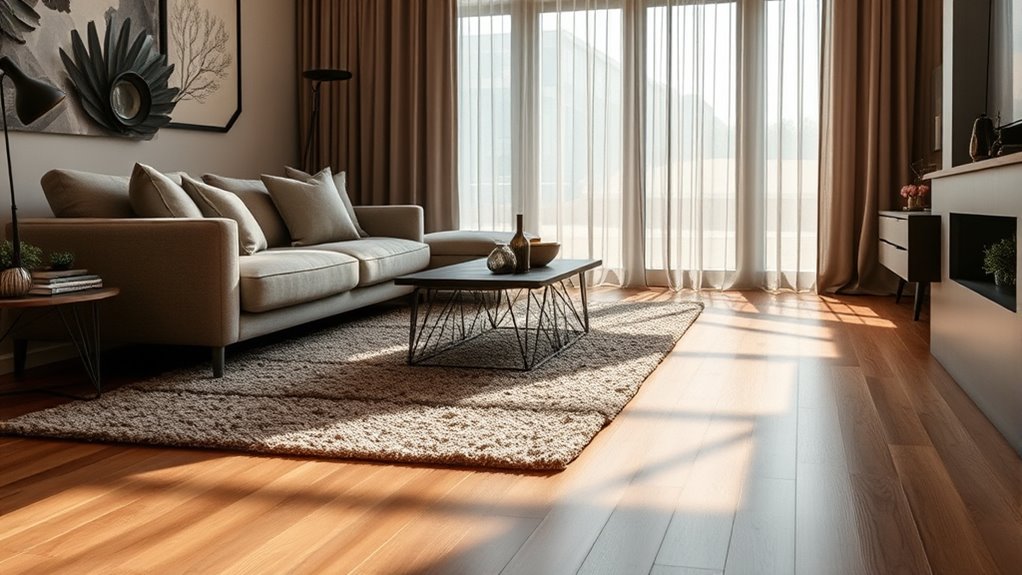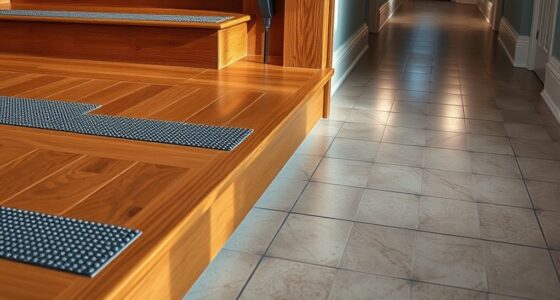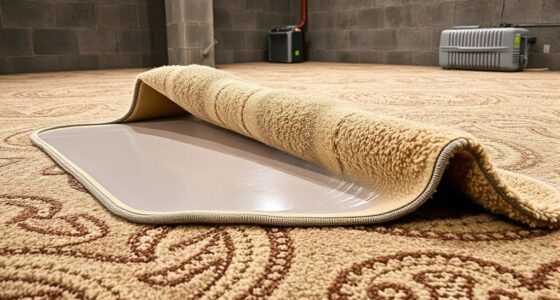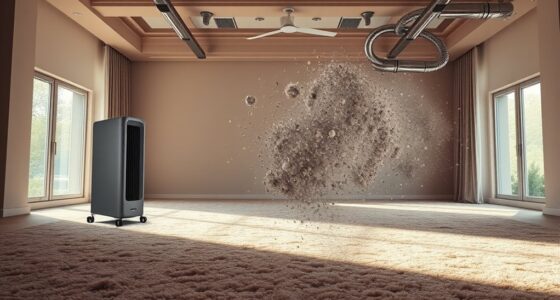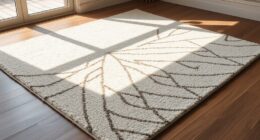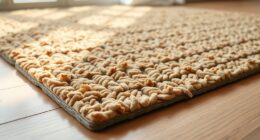Adding rugs can considerably cut noise levels by absorbing sound waves and reducing echo. Thick, dense, high-pile rugs made of natural fibers like wool are most effective, especially when placed in high-traffic or reflective areas. You might see decibel reductions of several points, making your space quieter and more comfortable. To learn how to optimize your rug placement and maximize sound dampening, keep exploring the detailed tips below.
Key Takeaways
- Thick, high-pile rugs made from natural fibers like wool offer the most significant decibel reduction.
- Larger rugs covering more floor space increase sound absorption and decrease overall noise levels.
- Placing rugs in high-traffic or sound-reflective areas enhances acoustic dampening.
- Layering multiple rugs or textures further improves sound absorption and reduces echo.
- Measuring noise levels before and after rug placement helps quantify decibel reduction effectiveness.
How Rugs Absorb and Dampen Sound
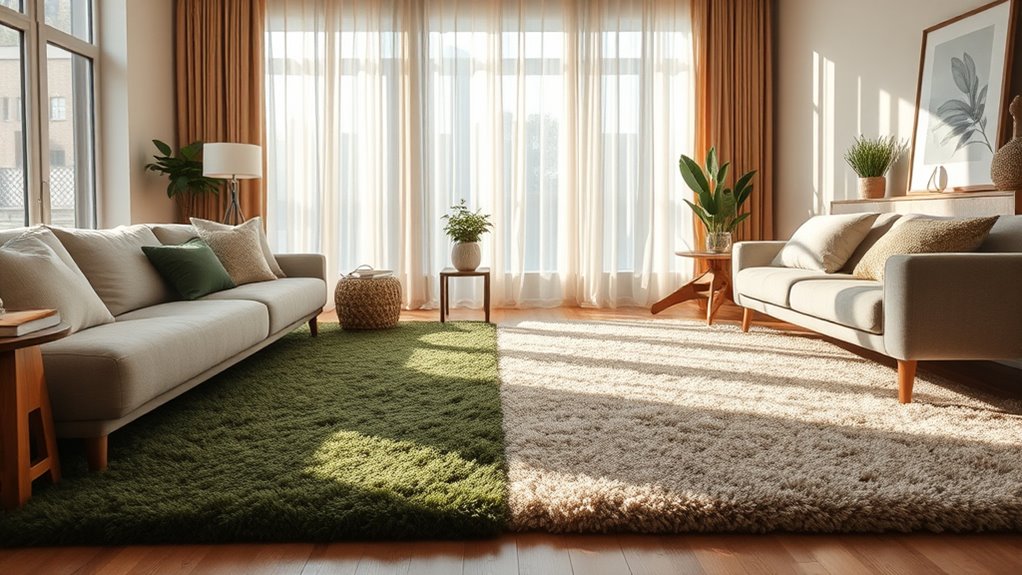
Rugs play a crucial role in improving sound quality within a room by absorbing and dampening noise. When you walk on a rug, your footsteps create sound waves that are partially absorbed by its fibers, reducing echo and footstep noise. The thicker and denser the rug, the more sound it can capture, preventing echoes from bouncing around the space. Rug fibers trap airborne sound waves, converting them into tiny vibrations that diminish their energy. This process is especially effective with plush, high-pile rugs that provide more material for sound absorption. Additionally, rugs break up sound reflections from hard surfaces like wood or tile, helping to create a quieter, more comfortable environment. Utilizing sound-absorbing materials such as rugs can significantly improve acoustic quality in your space. By choosing the right rug, you actively contribute to better acoustic quality in your space.
Factors Influencing Decibel Reduction With Rugs

The effectiveness of a rug in reducing noise depends on several key factors. First, the rug’s material plays a vital role—thicker, dense fibers like wool or shaggy textures absorb sound better than thin synthetic ones. Second, the rug’s size and coverage matter; larger rugs covering more floor area provide greater decibel reduction. The rug’s pile height also influences sound absorption—higher piles trap more sound waves. Additionally, placement is important; positioning the rug in high-traffic or sound-sensitive areas maximizes its benefits. Finally, the underlying surface impacts sound transmission—hard floors reflect more noise, so a rug on a tile or wood surface dampens sound more effectively. Incorporating sound absorption techniques can further enhance noise reduction in your space. Considering these factors helps you optimize your rug’s noise-reducing potential.
Types of Rugs That Maximize Acoustic Benefits
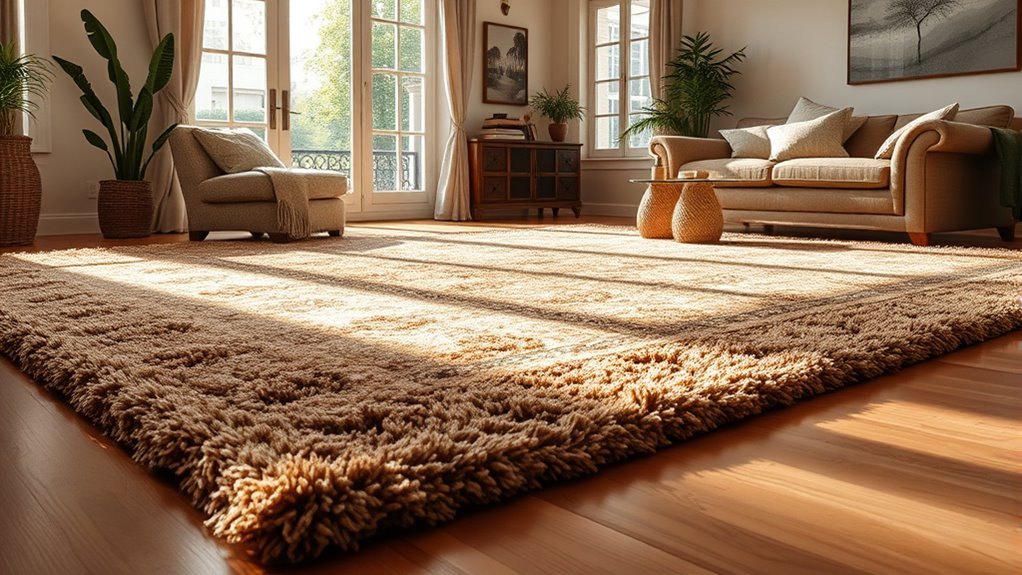
If you want to maximize acoustic benefits, choosing the right type of rug makes a considerable difference. Thick, dense rugs with high pile height, like shag or wool rugs, absorb sound more effectively. Natural fibers tend to outperform synthetic options because they better trap sound waves. Persian or Oriental rugs, with their intricate patterns and dense weave, also provide excellent sound dampening. Layering rugs or combining different textures can further enhance absorption. Avoid thin, low-pile rugs, which reflect sound rather than absorb it. The key is selecting rugs that are heavy and plush, as these qualities help reduce echo and noise transmission. Additionally, choosing high-quality materials that are designed for acoustic dampening can significantly improve your space’s sound environment. By choosing the right type of rug, you can considerably improve your space’s acoustic comfort.
Measuring Noise Reduction in Your Space

Ever wonder how effective your efforts are at reducing noise in your space? To find out, you need to measure the noise levels before and after adding rugs. Use a sound level meter or a smartphone app designed for noise measurement. Place the device at ear level in the main listening area for accurate readings. Take multiple measurements at different times of day to account for variability. Record the decibel levels consistently to track changes. Comparing the readings reveals how much noise your rugs have absorbed or deflected. Keep in mind that ambient factors, like background noise, can influence results. Regular measurements help you assess your progress and determine if further adjustments are necessary to optimize acoustics. Additionally, understanding sound absorption can help you select the best rugs and furnishings to improve your space’s acoustics effectively.
Tips for Optimizing Rug Placement for Better Acoustics
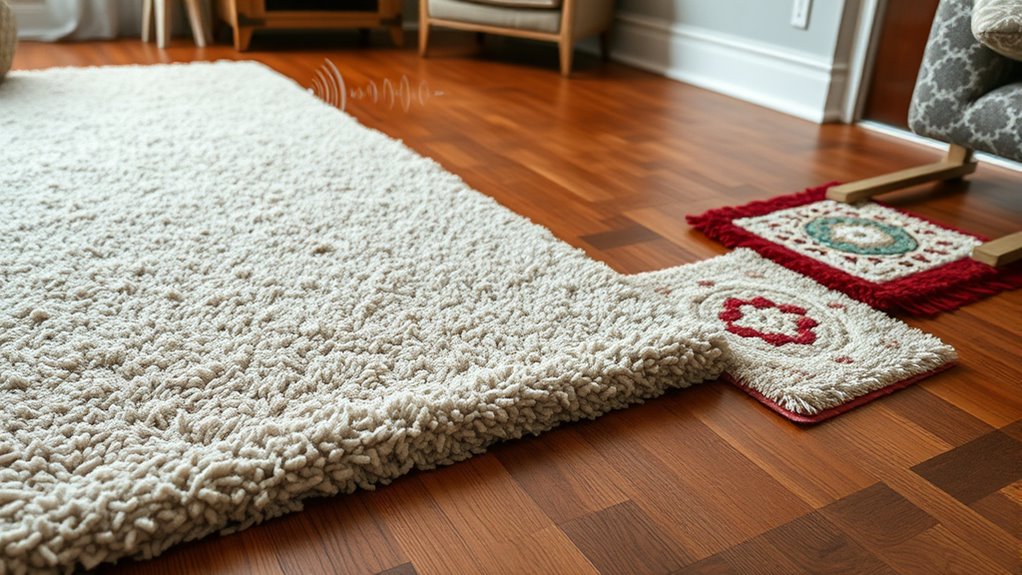
To maximize the acoustic benefits of your rugs, focus on their placement within the room. Position rugs in high-traffic areas where sound tends to bounce or reflect, like in front of sofas or under dining tables. Place larger rugs in the center of the room to absorb more sound and reduce echo. Avoid placing rugs solely along the walls, as this minimizes their effectiveness. Layer rugs or combine different textures to enhance sound absorption further. If possible, position rugs near hard surfaces such as glass or hardwood floors, where sound reflections are strongest. Consider the room’s layout and identify areas where noise tends to concentrate. Color accuracy and the properties of different textures can influence how well rugs absorb sound, so choosing the right materials can further improve acoustics. Thoughtful placement ensures your rugs effectively dampen sound, creating a quieter, more comfortable space.
Frequently Asked Questions
How Long Does It Take for Rugs to Effectively Reduce Noise?
You wonder how long it takes for rugs to effectively cut down noise. Usually, you’ll notice a difference immediately after placing rugs, especially if they cover high-traffic areas or hard floors. However, the full impact might take a few days as the rugs absorb sound and reduce echo. Consistent use and proper placement enhance their soundproofing, so patience and strategic positioning will give you the best results over time.
Do Rug Colors or Patterns Influence Sound Absorption?
Did you know that darker-colored rugs can absorb more sound than lighter ones? When it comes to sound absorption, rug colors and patterns don’t substantially influence how well they reduce noise. Instead, the material, pile height, and thickness matter more. You should focus on choosing dense, plush rugs for better noise control. So, pick patterns and colors that suit your decor; your soundproofing will improve regardless of the design.
Can Rugs Reduce Noise Through Walls or Just Floors?
Rugs mainly reduce noise on floors, but they can also help lessen sound transmission through walls if placed strategically, like against shared walls or doors. While their primary function is to absorb sound at the source, they don’t block sound as effectively as dedicated insulation. To improve overall noise reduction, combine rugs with wall panels or acoustic treatments. This way, you create a quieter, more comfortable space in your home.
Are There Specific Rug Materials Best for Soundproofing?
Ever notice how a cozy rug can suddenly make a room feel quieter? When it comes to soundproofing, look for rugs made from dense materials like wool or plush synthetic fibers. These materials absorb more sound and reduce noise transmission better than thinner options. So, if you want to dampen noise, choose rugs with thicker, densely woven fabrics—your ears will thank you, and your space will feel more peaceful.
How Do Rugs Compare to Ceiling or Wall Treatments for Noise Reduction?
When comparing rugs to ceiling or wall treatments, rugs mainly absorb sound at floor level, reducing noise reflections and footsteps. Ceiling and wall treatments, however, target soundproofing more broadly, blocking and absorbing noise across the entire space. Rugs are easier to install and add warmth, but for significant decibel reduction, combining them with wall or ceiling solutions is more effective. You’ll get better overall noise control by using both.
Conclusion
By adding rugs, you not only soften your space but also unexpectedly silence the chaos around you. It’s funny how such simple decor can turn down the volume, making your home cozier and calmer. When you choose the right rug and place it thoughtfully, you might find yourself surprised at how much quieter your room becomes—like a little secret just waiting to be uncovered. Sometimes, the smallest changes make the biggest difference.
